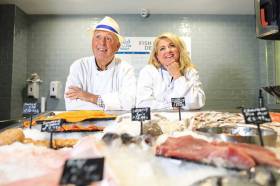Displaying items by tag: fishmonger
Launch of Ireland’s first Certified Fishmonger Qualification
Ireland’s first accredited fishmonger qualification has been launched today in the fishing port of Howth, Co Dublin. Bord Iascaigh Mhara (BIM), Ireland’s seafood development agency, has developed the Certificate in Fishmonger Skills accredited by nationally and internationally recognised Quality and Qualifications Ireland (QQI).
Ian Mannix, BIM described how the aim of the training is to retain and attract talent into the industry. He said:
“ Today’s consumer has come to expect their fishmonger to have a broad knowledge of seafood. They want them to be able to advise them when they are at the counter. This new programme will provide solid, fully certified training to anyone working in seafood retailing; practical skills they can then apply in the industry Moreover, improved skills in the workplace will ultimately lead to better sales and better retention of staff.”
The new training combines practical and classroom learning and includes modules on seafood labelling, nutrition and food safety. The programme also includes hands-on demonstrations in fish fileting and culinary skills and is aimed at existing staff in seafood retailing or those interested in pursuing a career in the industry.
Master fishmonger, Hal Dawson is one of the trainers on the new programme. He has worked in the seafood industry since 1972. He said:
“ The new course will provide professionalism within the industry. Having this qualification on your cv, will give fishmongers a real advantage.”
The value of seafood retail sales in 2018 was €297 million according to the BIM Business of Seafood report. Sales of loose fish experienced the sharpest increase (+8%) in comparison to pre-packed (+1%). Salmon remains the number one fish species bought by consumers in Ireland. However, there has been a marked increase in demand for lesser-known species owing to higher awareness of sustainability and provenance.
Laura Desmond, National Sales Manager, Oceanpath, completed the pilot fishmonger skills programme in 2018. She spoke of how the training has given her more experience in grading fish quality and food safety and said:
“ I started out in sales and engineering and made a switch to the fish business when my mother passed away in 2010. I now manage Reid’s Fish Market and Oceanpath. I love the freedom of my job. I’m in my car, and get to share my passion and knowledge of seafood to fishmongers working in the different stores.”
I can go into any of our stores now and ensure we’re selling the best quality fish.
The Certificate in Fishmonger Skills is taking place in Dublin and Cork early 2020. To find out more or to request an application form, please email seafoodskills.ie or go towww.bim.ie
Dubliner is Young Fishmonger of the Year
A Dublin Fishmonger with three retail outlets has been declared Ireland’s Young Fishmonger of the Year. George Stephens of The Fish Market in Blanchardstown was declared the winner at the final held in Kinsale last night. He told Tom MacSweeney why he liked being a fishmonger in an interview above.
Stephens also has retail outlets in Maynooth, Co.Kildare and in Mullingar Town. A professional chef with eight years’ seafood retail experience, he works with his wife and business partner Anne, developing new ready-to-go seafood products and has recently launched a new range of freshly fried fish in his Blanchardstown store.
The competition, run by Bord Iascaigh Mhara, was extensively judged over the past two months by a team of judges assembled by the board. This included practical skills and business testing.
This is the third year of the competition and the award was presented at television personality Martin Shanahan’s restaurant, Fishy Fishy, in Kinsale.
Tara McCarthy, Chief Executive of BIM, said the competition is intended to encourage young people to seek careers in the seafood industry.
George Stephens received a specially designed trophy, a study trip to France and a cheque for €1,000






























































